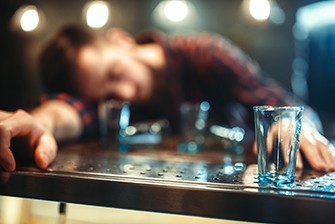Alcohol and the Brain: What Happens?
As most drinkers know, alcohol can cause many side effects on mood, behavior, and decision making. Alcohol has a large impact on the brain and how it functions, but what exactly happens to the brain? In addition, what are the long-term effects of alcohol and the brain and can treatment help?
Alcohol and the Brain of Young People
Although drinking alcohol at any age is dangerous, it is particularly dangerous for young people. This is because two areas of the brain are going through major developments and alcohol can severely impact this development. In fact, heavy alcohol abuse can cause development to slow or stop altogether. This makes education and drinking prevention measures especially important at a young age.
The two areas of the brain affected the most include:
- The hippocampus. This area of the brain is responsible for memory and learning. Studies of adolescents show that heavy and extended alcohol use is associated with a 10 percent reduction in the size of the hippocampus. It also shows that the function of the hippocampus is uniquely sensitive to alcohol at this time and that alcohol may be poisonous to the nerve cells of the hippocampus causing them to be damaged or destroyed.
- The prefrontal lobe. This area of the brain is important for planning, judgment, decision-making, impulse control, and language. In addition, it is the area of the brain that changes the most during the teenage years. Research with heavy drinking adolescents shows that these young people have smaller prefrontal lobes than young people of the same age who do not drink.
How Alcohol Interferes with Brain Activity
Most people know that alcohol interferes with how the brain functions, but what damages can happen between alcohol and the brain? (1, 2)
- Alcohol can completely block chemical signals between brain cells, which immediately leads to blurry vision, slurred speech, impulsive behavior, memory lapses, and slowed reflexes — also known as the symptoms of intoxication. 1
- As heavy drinking continues, the brain essentially adapts to these blocked signals, which cause the brain to over-activate neurotransmitters.
- After a person becomes sober from a night of drinking, the brain can continue over-activating these neurotransmitters, which causes uncomfortable (and sometimes fatal) withdrawal symptoms. This is also known as neurotoxicity, and these neurons can eventually burn out and die.
- When these neurons die, it causes brain shrinkage of actual brain matter that can lead to brain damage and life-long consequences.
Blackouts and Memory Lapses
Alcohol notoriously causes memory lapses and blackouts. These blackouts can often be unintentional, especially when a new drinker is experimenting with their drinking limits or trying different types of alcohol. According to a study by the journal Alcoholism: Clinical & Experimental Research, 90 percent of people who drink alcohol have experienced at least one blackout caused by alcohol.
Usually, with some water and a good night’s sleep, an individual is able to make a full recovery and learn from their mistakes. However, for people with high alcohol tolerance and dependency, this can become normal when they drink and can quickly become a red flag for alcohol use disorder. Either way, it is important to know what exactly happens during this reaction between alcohol and the brain.
Blackouts are periods of amnesia during which a person engages in activities but doesn’t create memories for these events as they transpire, according to the National Institute on Alcohol Abuse and Alcoholism. Essentially, alcohol impacts the brain’s activity to the point in which it actually blocks the brain from forming memories. Mix this with another one of alcohol’s side effects – lowered inhibitions – and you get the notorious recipe of performing risky behaviors and not remembering them.
How Recovery Can Heal The Brain
There is some good news for alcohol and the brain: in most cases, the brain is able to recover. In some cases, abstinence from alcohol can reverse much of the physical damage caused by heavy drinking. (3) In fact, the brain matter lost due to shrinkage can actually regrow within two weeks of becoming sober and continues to grow.
About Cliffside Malibu
The brain is just one of many parts of the body that alcohol can severely impact. Brain damage caused by alcohol abuse can lead to long-term memory, behavior, decision-making, and mood problems. Luckily, treatment can begin the process of reversing these damaging effects.
Since no two addictions are the same, Cliffside Malibu offers an individualized treatment plan for every client. We are committed to providing evidence-based treatment through a continuum of care model, including medically supervised detox, residential treatment, day treatment, and outpatient services. Our program also includes family therapy and holistic therapy, as well. Whether an individual is suffering from substance abuse and/or alcohol addiction, our programs are structured to create a supportive environment where healing can begin.
In addition to world-class treatment, Cliffside Malibu offers luxury accommodations, a serene environment, five-star dining, and plentiful amenities. We understand that addiction treatment is a rigorous process. Therefore, we provide for your comfort and relaxation at every turn, allowing you to rejuvenate, and meet the demands of treatment with your greatest energy and attention.
For more information on Cliffside Malibu, visit cliffsidemalibu.com
- SOURCES
Brust, J. C. M. (2010). Ethanol and cognition: Indirect effects, neurotoxicity and neuroprotection: A review. International Journal of Environmental Research and Public Health, 7, 1540–1557. - Clapp, P., Bhave, S. V., & Hoffman, P. L. (2008). How adaptation of the brain to alcohol leads to dependence: A pharmacological perspective. Alcohol Research and Health, 31(4), 310–339.
- Stavro, K., Pelletier, J. & Potvin, S. (2012). Widespread and sustained cognitive deficits in alcoholism: A meta-analysis. Addiction Biology, 18, 203–213.
